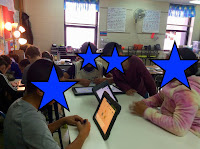I was lucky enough to take all 3 Blackboard classes when I was hired in the district as part of my TDP credits. So, the switch to using Blackboard as the delivery system for this school year seemed like it should be simple, right? I already knew everything I needed to know to get started! And, from what I remembered, many of the tools were similar to tools from other programs. You can add images, videos, text, links, no problem!
However, when I popped back into Blackboard for the first time this year, it didn't seem to be working the way I needed. In the spring, I had found a way to use Google products to create (what I hoped would be) kid-friendly materials that ALL students could navigate themselves rather than relying on adults at their house to figure it out. As I thought about how I made that happen in the spring, I realized it was not the program I chose to use but how I was able to organize the content that made me reach my goal.
The tool I found most helpful last spring was using icons. An icon is a graphic representation of something: a person, a place, or, in this case, content. I had created an icon to show kids where to click and one that reminded of how to put their device in present mode (arrows). There were also icons to show what they needed to watch, do and share (T.V., pencil, Google Classroom icon). This made my content easily accessible to all of my learners.
Good news: you can do that in Blackboard, too! Check it out for yourself:
You can also use icons to make your course accessible to all learners.
First, you need the actual icons, or pictures that will cue students. There are a few ways to do this:
- Search an icon using Google
- Find one on website thenounproject.com (all free and transparent background images)
- Create your own by using Google Drawings or Canva (Canva is an online graphic design platform that provides free pro accounts for teachers)
- You can place them directly into BB9 using the insert image function. To make this an active button that students can click, you would select the image and choose to link it to where students need to go.
For example, the first grade team at Hadfield designed their announcement page to be a collection of icons leading students to each separate content area. As students enter the BB9 course, they can easily choose the subject they are working by clicking on the picture that matches.
 |
2. Another option would be to put your icons on Google Slides. This option might feel a little more familiar to you especially if Slides is how you previously organized the materials for your students last spring like I did. Just like in BB9, your icon can added by using the insert image function and it be linked to whatever students might need access to complete their work. Once you have added your icon and links, you can embed the Slide directly into your BB9 course.
Below is an example from the music page at Hadfield. The table was created by using shapes in Google Slides so the icons and links could be organized by classroom teacher. An added bonus in using this method is that any changes you make within a Slide will be reflected in the embedded content on BB9 automatically. For instance, if the content needs to be assigned to a different homeroom as the specials rotation changes. That means once your Slide is embedded you do not have to make any changes directly to your BB9 course again.
Watch the tutorial on how to embed a Slide into BB9 to see the step by step instructions on how you can use this method of organizing your content by using icons: https://www.youtube.com/watch?v=nS1cjJxREPo&feature=youtu.be













